Underconsumption is a theory in economics that recessions and stagnation arise from an inadequate consumer demand, relative to the amount produced. In other words, there is a problem of overproduction and overinvestment during a demand crisis. The theory formed the basis for the development of Keynesian economics and the theory of aggregate demand after the 1930s.

Underconsumption theory narrowly refers to heterodox economists in Britain in the 19th century, particularly from 1815 onwards, who advanced the theory of underconsumption and rejected classical economics in the form of Ricardian economics. The economists did not form a unified school, and their theories were rejected by mainstream economics of the time.
Underconsumption is an old concept in economics that goes back to the 1598 French mercantilist text Les Trésors et richesses pour mettre l'Estat en splendeur (The Treasures and riches to put the State in splendor) by Barthélemy de Laffemas, if not earlier.[1] The concept of underconsumption had been used repeatedly as part of the criticism of Say's Law until underconsumption theory was largely replaced by Keynesian economics which points to a more complete explanation of the failure of aggregate demand to attain potential output, i.e., the level of production corresponding to full employment.
One of the early underconsumption theories says that because workers are paid a wage less than they produce, they cannot buy back as much as they produce. Thus, there will always be inadequate demand for the product.
- ^ Cited in Mercantilism, by Eli Heckscher, vol. ii, p. 290, who discusses other examples. They are cited and discussed by John Maynard Keynes in The General Theory, Chapter 23. Notes on Mercantilism, The Usury Laws, Stamped Money and Theories of Under-Consumption, section VII